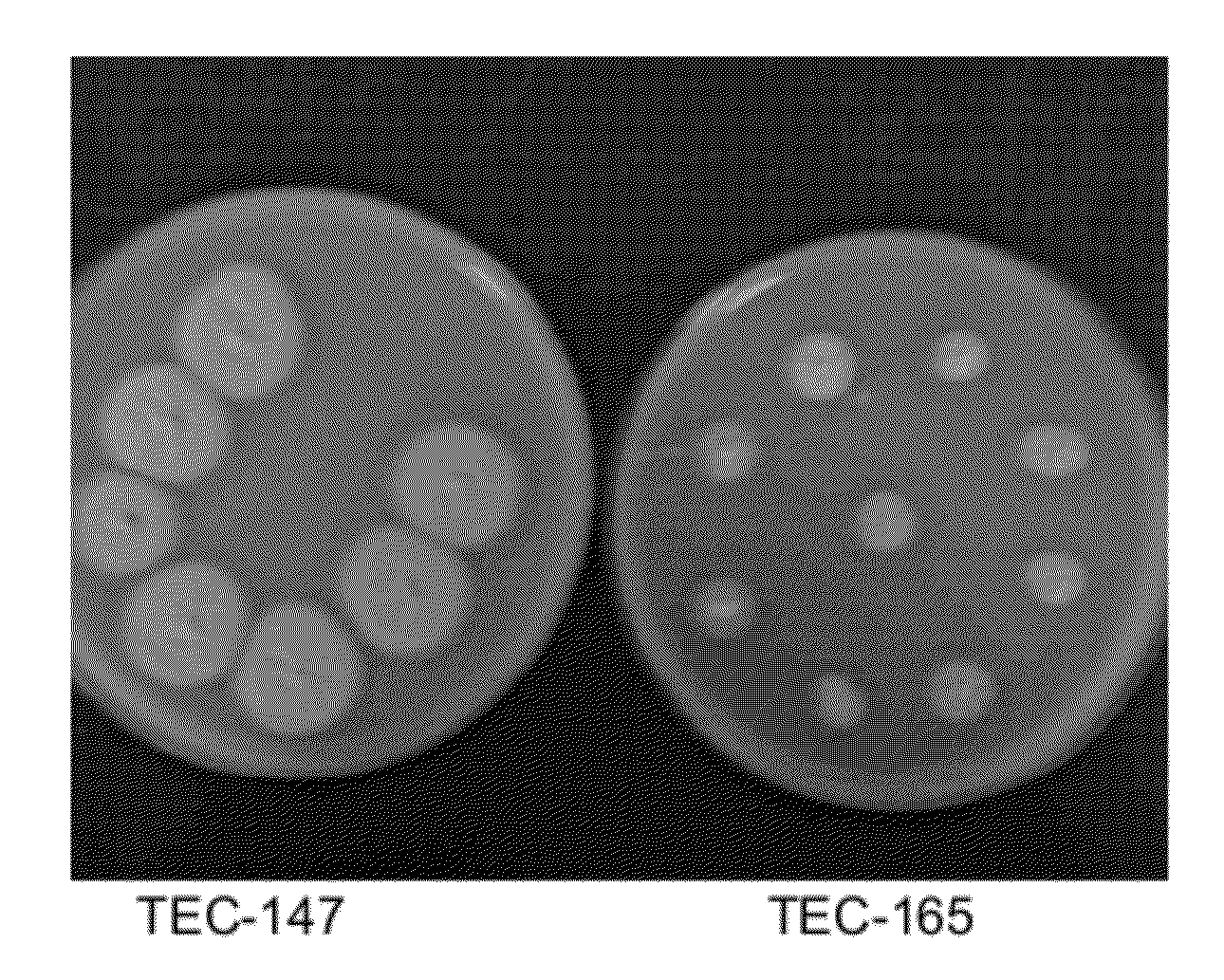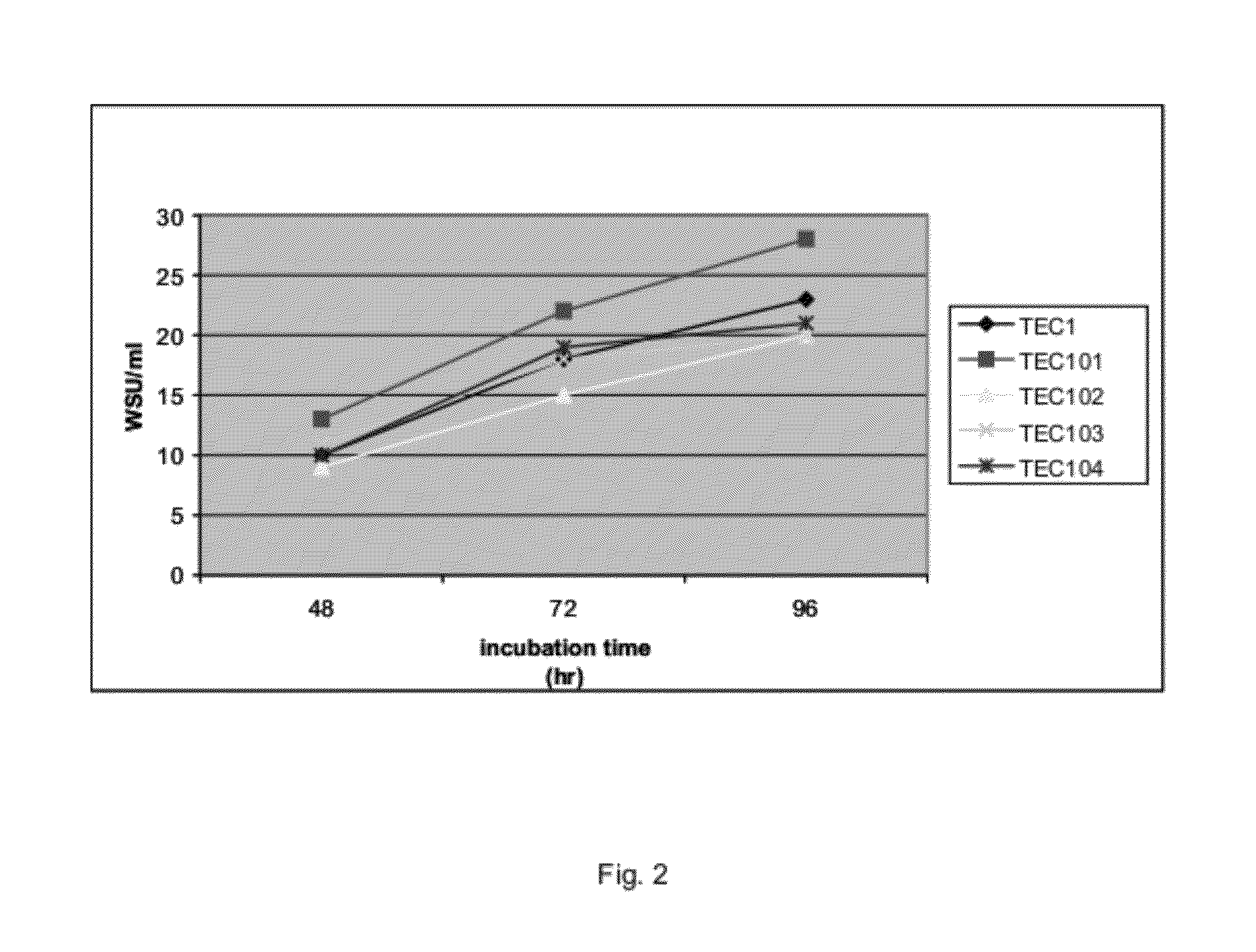Talaromyces strains and enzyme compositions
a technology of enzyme composition and strain, which is applied in the field of mutants of talaromyces, can solve the problems of limiting the commercialization of biomass bioconversion processes, the cost and hydrolysis efficiency of enzymes, and the enormous energy potential of these carbohydrates, and achieves good growth, good sporulation, and improved cellulolytic activity.
- Summary
- Abstract
- Description
- Claims
- Application Information
AI Technical Summary
Benefits of technology
Problems solved by technology
Method used
Image
Examples
example 1
[0336]This example describes isolation and characterization of colony morphology variants of T. emersonii.
[0337]Talaromyces emersonii is a thermophilic filamentous fungus. Sporulation on the standard FDA agar medium is very poor (6 / ml), growth on Talaromyces medium 2 gives improved sporulation (˜107 / ml). After plating serial dilutions of TEC-1A on Talaromyces agar medium plates, colonies with three different phenotypes can be discriminated (FIG. 1): TEC-101, distinct white aerial mycelia (80% of population); TEC-102 and TEC-103, reduced aerial mycelia (20% of population; two isolates recovered); TEC-104, no distinct aerial mycelia, brown color (1% of population). The phenotype of TEC-104 remained stable for many generations after growing on agar plates or liquid growth media. However for TEC-101, colony variants similar to TEC-104 continued to be produced at low frequency (<1%).
[0338]Sporulation tests indicated that TEC-104 produced the highest spore titers (>107 / ml). However in ti...
example 2
[0340]This example describes the isolation of improved cellulase production mutants of T. emersonii by high throughput screening of random mutants.
[0341]NTG-treated TEC-101 spores were plated from frozen stocks onto Talaromyces agar medium and grown for 4 days at 40° C. Approximately 6000 mutants were transferred into 96 wells microtiter plates (MTP) containing Talaromyces agar medium (200 μl / well). These MTPs, called “masterplates” were incubated at 40° C. for 5 days. Several wells were left blank to later contain the TEC-101 non-mutagenized parent and Filtrase® NL enzyme.
[0342]The masterplates were replica plated using an automated inoculation d vice into 24-well MTPs containing Talaromyces medium 4 (3 ml / well). To do this, physiological salts (150 μl / well) was added to the masterplate wells and the spore suspensions was transferred to the 24-well MTP. In addition, a new 96 well masterplate (200 μl / well Talaromyces agar medium) is inoculated in this protocol. The 24 well plates we...
example 3
[0350]This example describes the fermentation of cellulase-improved T. emersonii mutants.
[0351]Three of the cellulase producing mutants from random HTS screening, TEC-121, TEC-137, and TEC-142, and TEC-111; a spontaneous mutant of TEC-101 (previously call TEC-101*) were tested in 10-liter production fermentor as batch fermentations. As controls, additional strains were similarly evaluated: TEC-1A, original starting strain and TEC-101, the common colony variant of TEC-1A, which was the direct parent of the mutants.
[0352]At the end of fermentation (96 hr), TCA-Biuret analysis revealed that the total protein concentration was in the range of 9-10 g / kg in all cases. Only for mutant TEC-142 were protein levels significantly higher measuring approx, 16.4 g / kg (Table 2).
TABLE 2Summary of 10-liter fermentor batch fermentation of T. emersoniicellulase production mutants and parental strains.Cellulase activity afterTCA-96 hours fermentationProteaseBiure(WSU / BGEG(acid)protein16xdilution(WBDG / (...
PUM
| Property | Measurement | Unit |
|---|---|---|
| Fraction | aaaaa | aaaaa |
| Fraction | aaaaa | aaaaa |
| Mass | aaaaa | aaaaa |
Abstract
Description
Claims
Application Information
 Login to View More
Login to View More - R&D
- Intellectual Property
- Life Sciences
- Materials
- Tech Scout
- Unparalleled Data Quality
- Higher Quality Content
- 60% Fewer Hallucinations
Browse by: Latest US Patents, China's latest patents, Technical Efficacy Thesaurus, Application Domain, Technology Topic, Popular Technical Reports.
© 2025 PatSnap. All rights reserved.Legal|Privacy policy|Modern Slavery Act Transparency Statement|Sitemap|About US| Contact US: help@patsnap.com



